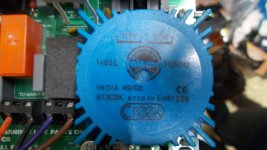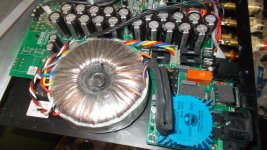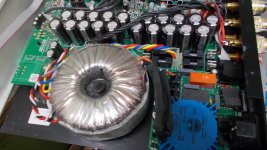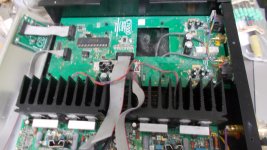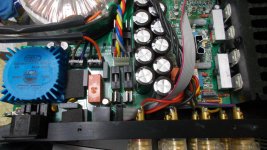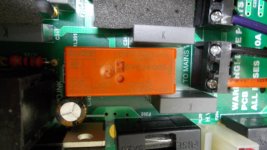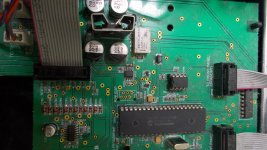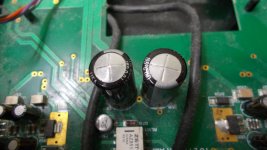Take a look at more images here: http://oukas.info/?u=Creek+Destiny+Amp++What+HiFi
I think you'll find that a separate, specific type of low current transformer is required for safety reasons when a consumer device is designed to be in standby mode 24/7. The power amplifier itself is then only powered on/off by a mains rated relay, operated in turn by remote control logic and the microcontoller chip, all of which are necessary for full remote control operation.
Most up-market consumer hi-fi products now have a similar, isolated standby power supply for the purpose. The transformers used for the control circuit are normally tiny, safety rated E-I laminated types and only about 3-7VA rated. This is Creek's unusual implementation with a toroid - perhaps they already had plenty of suitable toroids in stock at the time.
I think you'll find that a separate, specific type of low current transformer is required for safety reasons when a consumer device is designed to be in standby mode 24/7. The power amplifier itself is then only powered on/off by a mains rated relay, operated in turn by remote control logic and the microcontoller chip, all of which are necessary for full remote control operation.
Most up-market consumer hi-fi products now have a similar, isolated standby power supply for the purpose. The transformers used for the control circuit are normally tiny, safety rated E-I laminated types and only about 3-7VA rated. This is Creek's unusual implementation with a toroid - perhaps they already had plenty of suitable toroids in stock at the time.
Are these things reliable, do they fail (I suppose anything can fail!) because this amp does not power up and it is difficult to test because you have to disconnect the wiring to get at the circuit board underneath. The LED will flash yellow for less than a second then no light and if you switch it off then on again it does not even flash on. You'd have to leave it for maybe a hour to even get the brief yellow flash.
Ok. Replace both of those caps as part of your service. Same voltage, capacitance and temp rating.
Lift the black foam off the talema board and let's see what's under there, I assume it's a MOV or ballast resistor.
they're just covering live contacts
After that it's a case of tracing from the mains input inwards to see where you stop getting power.
I'd pull the entire standby softstart board and just wire the main transformer into the wall. Making sure you follow the lead labelling on the traffo. Looks like it's a dual 115v input transformer wired in series for uk 230v ish mains. If that works you know it's the softstart board.
Given you asked what the blue box was now might be the time to ask. Are you sure your safe enough to mess with mains voltages? If not time to phone a friend.
I'd pull the entire standby softstart board and just wire the main transformer into the wall. Making sure you follow the lead labelling on the traffo. Looks like it's a dual 115v input transformer wired in series for uk 230v ish mains. If that works you know it's the softstart board.
Given you asked what the blue box was now might be the time to ask. Are you sure your safe enough to mess with mains voltages? If not time to phone a friend.
Whilst it's good to hear that a just bit of percussive maintenance brought the relay back to life, I would be concerned with what caused the relay to stick at all. My experiences with failed power relays have all been with either fused or grimy contacts. It may work for some time now, but I would mindful that whatever prevented the relay contacts from closing is likely to do it again - check for debris or tiny pitting of the contact faces inside the relay before closing it all up. Don't touch anything that's powered though!
Last edited:
Whilst it's good to hear that a just bit of percussive maintenance brought the relay back to life, I would be concerned with what caused the relay to stick at all. My experiences with failed power relays have all been with either fused or grimy contacts. It may work for some time now, but I would mindful that whatever prevented the relay contacts from closing is likely to do it again - check for debris or tiny pitting of the contact faces inside the relay before closing it all up. Don't touch anything that's powered though!
it's a sealed unit so I'll be replacing it
I think lack of use was the cause , the amp had been idle for a while
RTE24005 | TE ConnectivityRT2 DPDT Non-Latching Relay PCB Mount, 5V dc Coil, 8A | RS Components
- Status
- This old topic is closed. If you want to reopen this topic, contact a moderator using the "Report Post" button.
- Home
- Amplifiers
- Solid State
- Creek Destiny Power Amplifier... what is this?
